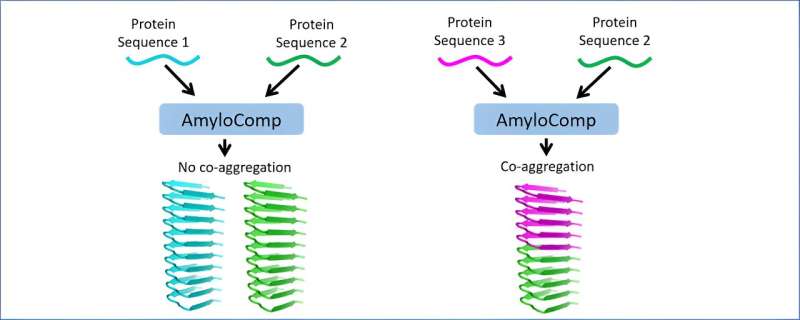This article has been reviewed according to Science X's editorial process and policies. Editors have highlighted the following attributes while ensuring the content's credibility:
fact-checked
peer-reviewed publication
trusted source
proofread
Geneticists develop world's first bioinformatic tool to identify amyloids consisting of multiple copies of same protein

Scientists from St Petersburg University and the University of Montpellier have developed the first software enabling the prediction of pairs of proteins in amyloid fibrils capable of co-aggregation, i.e. a process by which proteins become attached to one another. Their studies have shown an accuracy of more than 94%. The work is published in the Journal of Molecular Biology.
Amyloids are protein aggregates that are associated with a number of severe and incurable diseases, such as Alzheimer's, Parkinson's, and Huntington's to name just a few. Yet, the presence of amyloid is not always pathological; many of them have functional, 'beneficial' roles in cells. What can trigger aggregation into amyloid fibrils is changes in protein structure, scientists say. In the last few years, however, a considerable body of data has been accumulated about co-aggregation of different amyloid-forming proteins.
The team of geneticists and biotechnologists from St Petersburg University and the University of Montpellier (France) was the first in the world to propose a bioinformatics approach AmyloComp to identify pairs of proteins capable of co-aggregation, i.e. binding with each other. The software is written in the Python programming language and is available as an online application.
"Amyloid look like fibrils. They form a kind of 'stack' of many molecules located across the fiber. Traditionally, amyloid fibrils consist of multiple copies of the same protein. In this case, they are homogeneous and have the same structure. Yet, what we are trying to find is co-aggregation of different proteins in a common fibril, i.e. a stacking of different proteins within the same amyloid fibril," said Stanislav Bondarev, co-author of the study, Associate Professor in the Department of Genetics and Biotechnology at St Petersburg University.
According to Stanislav Bondarev, the AmyloComp software developed by the University scientists demonstrates an accuracy of more than 94% on a model data set and also reliably classifies known positive and negative examples of protein co-aggregation. Thus, protein co-aggregation can play various biological roles in the body.
On the one hand, the 'amyloid cascade' hypothesis was proposed quite a long time ago. The hypothesis assumes that pathological amyloid aggregates can trigger the aggregation of other proteins. On the other hand, some important biological processes require co-aggregation of different amyloid-forming proteins. Among known examples of the co-aggregation are human proteins RIPK1 and RIPK3. This co-aggregation is part of the signaling cascade when triggering the antiviral response. The AmyloComp software can identify similar examples on the proteome scale.
The bioinformatic tool is unique. Other bioinformatic approaches do not model co-aggregation of two amyloid proteins. The method developed by the St Petersburg University researchers is based on a comparison of the amino acid sequence of two proteins and takes into account the possibility of stacking of different proteins within the same amyloid fibril. This approach makes it possible to identify different sequences that form a single structure.
More information: Stanislav A. Bondarev et al, AmyloComp: A Bioinformatic Tool for Prediction of Amyloid Co-aggregation, Journal of Molecular Biology (2024). DOI: 10.1016/j.jmb.2024.168437




















